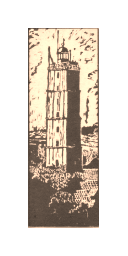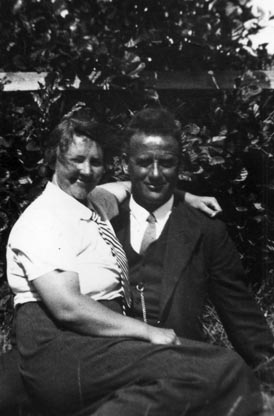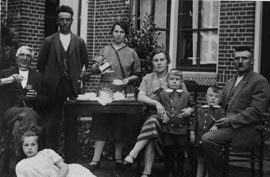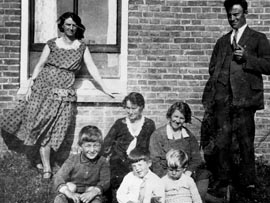
Hinne de Jong
A Chronicle
translated/arranged by his son, Sense de Jong
Hinne meets his true love
- 1: Introduction
- 2: Captain Pieter
- 3: Childhood years
- 4: Shipwreck
- 5: Teenager
- 6: Spring remembered
- 7: That's how it was
- 8: Pre World War I
- 9: Mobilization (1914-1918)
- 10: Boys will be boys
- 11: Hinne leaves Terschelling
- 12: Hinne meets his true love
- 13: An eventful move
- 14: A serious illness
- 15: The war years (1940-1945)
- A1: Memories of Pa (by Truus)
- A2: Memories of Moe (by Truus)
- A3: Pa talks again
- A4: Cornelis Jacob de Jong
Another site by Sense de Jong:
~ Sense de Jong ~
Reminiscences
Sites by Henry de Jong:
~ Herman de Jong ~
Memorial
~ Newmaker Notes~
Writings, Pictures, Collections
~ AACS/ICS Niagara Conferences~
1970 - 1991
Hinne wrote a great deal about his experiences working for his employer, the “Nederlandse Heidemaatschappij.” (NHM). He was sent to job sites far and near, especially before his marriage. It was all part of a learning experience as an “aspirant opzichter,” i.e. he was aspiring to become a registered supervisor with the NHM.
After successfully passing his entrance exam at the NHM school in Arnhem, he was called up to go to his first assignment. The date was March 1, 1919. The location? IJsselmuiden, close to the old Hanseatic City of Kampen. There, Hinne and a young fellow from the Province of Zeeland were boarding with an elderly Roman Catholic couple. At night, they heard them pray through all the steps of the rosary - a new experience for these rookie NHM-ers.
Hinne’s companion, Kees Janse, wasn’t used to the heavy work required of them on a large, horticultural farm. Poor Kees! He was used to office work indoors and was sometimes so discouraged that he wanted to quit. Hinne tried to help him through it all. Later, Kees became a top-student in his class. After the Arnhem school, he left for what was then called the Netherlands East Indies (Indonesia) and died there only a few years later.
After a few months working in IJsselmuiden, Hinne was transferred to Leersum, which lies between Driebergen en Wageningen, a beautiful part of Holland. Here, Hinne’s work was mainly in the area of forestry, in other words, he became a student of sylviculture. An interesting thing happened to Hinne here....
The castle’s maiden
Following the Peace Treaty of Versailles - which ended the WW I (1914-1918) - the German Emperor, Kaiser Wilhelm II, sought asylum in Doorn, the Netherlands, which was close to the area of Hinne’s job assignments. Queen Wilhelmina approved the request for asylum.
The great man lived in a castle. He loved the outdoors and Hinne often saw him working in the garden. He also became acquainted with one of the maids at the castle. Hinne wrote: “She was very nice and I think I kind of fell in love with her!”
They arranged to meet on Sundays, when both were off work. And so, Hinne and the castle’s maiden walked and talked together, strolling through the beautiful woods of that area. She came from the City of Nijmegen. The relationship, however, didn’t last long. Hinne’s life went on and he forgot about her, he wrote.
Hinne’s next stop was in Aarle/Rixtel, in the Province of Brabant. Again, he had to do much fieldwork. That area was known for its willow trees. The willows were harvested and shipped in huge quantities to the large “Afsluitdijk” project where they were used to strengthen the dike that later closed off the “Zuiderzee” to create what became known as the “IJsselmeer.”
As mentioned earlier, the classes at the Arnhem NHM school started on October 1, 1919. Hinne had to get used to being indoors during the day and doing his homework each night. Fortunately, some of the teachers took the students into the woods for practical, hands-on lessons.
In 1920, Hinne went to assignments in Tilburg (Brabant), Almelo (Overijssel), then to Rips (Brabant). Hinne wrote that from Rips he often went with a three-wheeled wagon, pulled by a large Belgian horse, to the Peel, an immense area close to the Limburg border. He’d spend long days there plowing the land. He nearly got killed doing this work. One day, the huge horse kicked backwards with a hind leg , hitting Hinne and throwing him to the ground. Hinne picked himself up, sore but not badly hurt, and carried on. He never knew why the “Belg” had done that.
After several study periods in Arnhem, Hinne received his diploma in March 1921. His next assignments took him to Almelo (Overijssel), and then to Coevorden, Hardenberg and Burgeroostveen (Drenthe).

Hinne meets his true love.
Hinne, and his colleague van Putten, became boarders with the family Blokzijl in Klazienaveen (Drenthe). They really liked it there, not in the least because “Moeke” Blokzijl became like a second mother to them. The Blokzijls had a dog which hated the sight of van Putten for some reason or another. One morning the dog ripped van Putten’s shoes apart. And that was it for him!
He left and found another place to stay. Hinne stayed at the Blokzijls.
And this is how Hinne met his future wife Hebowina Jantina Klazina (“Wine”). One day, Hinne noticed that another daughter (there were many Blokzijl daughters!) had come home for a few days of vacation. He hadn’t seen this one before. He learned she worked in the City of Groningen and went by the name Wine (pronounced “Whea-na”). He later learned that Wine had wondered what kind of a guy Hinne was. Being in the sun all day, Hinne was as brown as a negro. But she was attracted to him. And, as far as Hinne was concerned, the feeling was mutual.
Hinne wrote: “At that time I was still engaged to Grietje Lamers, but we were having problems!” He subsequently broke off the engagement. Grietje lived in Drachten (Friesland) where Hinne’s sister, Trijntje, also lived with her husband Carel Funcke. Naturally, Hinne often visited the Funckes during his engagement to Grietje.
.
Back in Klazienaveen, Hinne also got to know Martha, one of Wine’s many sisters. Martha was a very, very, funny person. Together they had a great time. The relationship between Hinne and Wine blossomed and had the approval of their parents.

During their courting period, Hinne would travel every two weeks to the City of Groningen where Wine was employed at a school of domestic science, located on the Kranenweg. While in Groningen he would find lodging with another one of Wine’s sisters.
But Hinne was still on the go. His next assignment took him to the District of Heerenveen (Friesland). Not much later he had to pack again: this time to the District of Vlagtwedde, in the Province of Groningen. There, a 14-kilometer-long canal had to be dug through the peat bogs of Westerwolde, an immense job.
After living in a few boarding houses, Hinne realized he would probably stay in this area for some years. So, he and Wine decided to get married.. The wedding took place on May 21, 1926. Hinne was then 30 years of age, while Wine was only 24. They settled in nearby Veelerveen, a little village in the Municipality of Bellingwolde.

Two gifts from the Lord
On March 8, 1927, Cornelis Sense (Cees) was born in their home, a former office of a large potato factory. And what a beautiful boy he was, with all that curly black hair. He was adorable.
Soon, however, they had to move to another place, a home in Vlagtwedde. Hinne wrote how cold it had been that winter. One day, to keep little Cees warm, they had put his small bed close to the “kachel” (stove). A whistling kettle came to a boil on top of the stove. Suddenly, horror of horrors, the whistle shot off and a stream of boiling water escaped, narrowly missing the baby’s head. It was a miracle Cees was unharmed.
In this house, in Vlagtwedde, Geertruid Trijntje (Truus) was born on September 14, 1928. Hinne and Wine often disagreed later as to exactly which house it had been, because during their stay in Westerwolde they had moved four times.
Hinne’s family was growing.

[an error occurred while processing this directive]